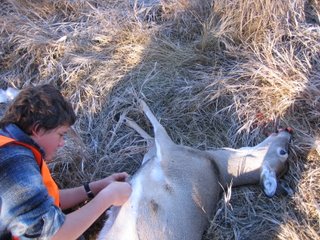28 November 2006
Rifles and Hunting Memories
In my own case, I was fortunate to have been raised by my grandfather and to have experienced hunting with him and many of his friends. They were a dedicated lot who hunted everything they legally could (well, and sometimes some things they legally could NOT): white tailed deer & black bear, turkeys & pheasant & ruffed grouse & woodcock, squirrels & cottontail rabbits & snowshoe hares, and ‘coon & fox.
Gramps worked with Bernard Dutka, who owned a truck garage. During hunting season most anytime and throughout the year at lunchtime men gathered around the big coal-fired potbelly stove. They argued cartridges and rifle & shotgun actions and philosophical questions such as, “Who owns the deer?” and “What does it mean to be a good hunter?”
Gramps hunted deer and bear with a Winchester M55 takedown 30-30 with open sights (ivory bead front) and Mr. D used a Savage M99 300 with scope. I could never shoot Gramps’ 30-30 well, in part because I found the narrow steel butt plate and sharp comb punishing. He was deadly with it, however, up to about 200 yards. The M99 was by far the most popular rifle model, with a few in 250-3000. Other choices ranged from the Courteau family’s proclivity for 410 shotgun slugs (they didn’t kill many deer) to my uncle’s 270. One guy who always killed his buck swore by his Savage bolt action 22 Hornet. For some reason there were very few military surplus rifles (“sporterized” or otherwise), which seem to be fairly common in Montana. I began with a lightweight Sako in 308. It was my Dad’s new rifle and he foolishly boasted that if I killed a buck my first year (I was 12) the rifle was mine. Mr. D helped insure that I did indeed kill a buck, and he also insured that Dad kept his word. I still have this rifle, and I’ve killed a bunch of elk with it since moving to Montana in 1990.
Bernie’s Truck Garage also functioned as a sort of butcher shop, especially in the evening on the first day or two of deer season, and on the weekends. By the age of 11 I was skinning and quartering deer in exchange for the hide—which usually sold for about three dollars. It seemed like a lot of money at the time. On a busy evening I might skin and quarter six or so deer, but in those days a buck was hard to come by and there were usually just two or three. The two-day long doe season could be very busy, and my grandmother got angry because I would be at the garage until nearly midnight. I needed help with the meat saw but handled the skinning myself. The experience was especially rewarding because I could also take in the hunting talk of the men, and because I could observe the various ways deer were shot. Single shots through the ribs or to the neck; multiple wounds with gut shots, broken legs, and bloodshot haunches; and tales of wounded deer never found. I like to think this experience (along with my own mistakes, truth be told) made me a little choosy about how and where I shoot deer.
At the same time I was reading every magazine article about hunting and rifle/cartridge selection that I could get my hands on, which is how I learned of Ned Roberts .257 wildcat based on 7 X 57 Mauser. We also had a renowned custom rifle shop – Clare Taylor & Don Robbins -- near my town. They built mostly bench rest competition rifles, but were advocates of small bore high velocity cartridges, and I absorbed some of their enthusiasm. Somehow, all of this culminated in my buying the Winchester M70 Featherweight—the only new rifle I’ve ever bought. For some reason, I have always been skeptical of new commercial calibers (though I esteem wildcats), especially the so-called magnums. I’ve had four friends and hunting partners who used magnums (two 300 Winchester fans, one 7mm Remington, and one 338 Winchester). Three were lousy-to-mediocre shots, and at least one of them has come to terms with the problem and given up the magnum. My dear deceased friend Ray Ott shot the 7 mm, and he shot it as comfortably and as accurately as I shoot my little 25 Roberts.
As for bullets, until recently I used Hornaday’s 100-gr soft point and was happy enough with their two inches at 100-yards accuracy. Several years ago I switched to Nosler’s 100-br boat tail “ballistic tip”—primarily because a friend gave me a few to try out, and they proved to be phenomenally accurate (sub moa) in my rifle. A dozen or so deer and three antelope later, and I am a little uncertain about their performance—they seem to be more “explosive” than the Hornaday, especially at close range. I’ll give them another year or two on deer and antelope before switching back.
Just this year, because I anticipated my hunting apprentice using the 25 Roberts for elk, I tried some 100-gr Barnes all-copper X bullets. They are very accurate, also, and did a very good job on AJ’s cow elk. He shot her high through the lungs at long range (well over 200 yards) and the bullet made a big hole, taking a rib on the way out. Elk can go a long ways on a high lung shot, and this cow did (well over a half-mile)—but she also ran only downhill and was pretty well bled out when AJ & I got to her. I decided against the heavier (115-gr or 120-gr) Barnes because they are a very long bullet (copper density being lower than lead) and the heavier bullet would have to be seated very deeply, cutting into powder capacity. Also, I have shot Nosler and other 115-120 gr bullets in this rifle, and they never shot particularly well. 87-gr bullets shoot about as well as 100-gr, but I quit killing ‘chucks and coyotes and foxes a long time ago.
27 November 2006
The "25 Roberts" rifle (aka .257 Remington Roberts)
It took awhile. After dozens of deer shot with everything including a 222 Remington, 20 ga shotgun slugs, and a 308 Winchester, I was working at an oil refinery in Bradford, Pennsylvania, and had a little folding money to spare. It was the late 1970s, and Winchester had reintroduced its M70 Featherweight. A local gunshop ordered me one in 25 Roberts.
It proved to shoot accurately with 50 grains of IMR 4350 pushing 100 grain Hornaday softpoints. I've since reduced that load to 48 gr, since occasionally with warm weather the load has proved a little too hot--leading to cratered primers and sticky ejection. For bullets, I've switched to 100-gr Nosler "blue tip" boattail softpoints, a super accurate bullet suggested by my friend Don Kieffer (from whom I recently re-acquired a 25-06 Browning, after having traded him the rifle some years prior to that). I also like the 100-gr Barnes all copper bullet--it is accurate, holds together on elk, and has not caused the copper fouling problems reported by some.
The 25 Roberts is a low recoil round that kills deer and antelope very well. I do not like shooting big magnum rifles and the flinching (bad shooting) habits they induce in most users. The 25 Roberts is also light to carry, something I appreciate when stalking mule deer up and down the rugged canyons of the lower Big Hole River valley. While the 25 Roberts is not the best choice for an elk rifle, it did kill a nice bull elk (1 shot) last year that happened to be feeding with a bunch of mule deer. Also, my hunting apprentice AJ used the little rifle to kill his elk cow this year. The first shot was at rather long range (well over 200 yards), and the second shot (delivered after the cow made it to the bottom of a steep walled valley and lay down, where AJ caught up with it) was probably superfluous.
On many deer hunts over the years, hunting partners have used my 25 Roberts to kill their deer. Sometimes, this has been after they missed a deer with their own rifle. I think some people are just careless about working up a good load in their own rifle and shooting it enough to have confidence in it (and to KNOW it’s sighted in!) but this has lent my rifle an almost magical reputation.
Visit to Boston & Keene, New Hampshire
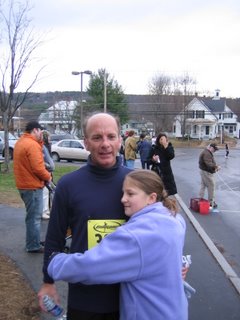
 On Friday we visited the family cottage at Silver Lake. Sarah collected white pine and hemlock boughs for decorating, and we all reminisced about good visits there in summers past. I think this might have inspired Jan & Sarah to buy lobsters for supper--a treat greatly appreciated by everyone (including Jane, who returned home Friday before dark). Before supper, Emily Wilson demonstrated an immediate knack for using my little digital camera. She made an investigative documentary about laxatives. According to Emily, Sam, and Calvin, colleges routinesly add laxatives to cafetaria food. EW's documentary included a discourse into epistemology (led by Andy): If people believe something, does that make it true? Well, as Emily argued, it increases the likelihood that it could be true. Hmmm... I think Emily & I will read& discuss Plato's Socratic dialogues over Christmas break. After supper and a lively game of dictionary (talk about majority opinion creating truth!), we all called it a night.
On Friday we visited the family cottage at Silver Lake. Sarah collected white pine and hemlock boughs for decorating, and we all reminisced about good visits there in summers past. I think this might have inspired Jan & Sarah to buy lobsters for supper--a treat greatly appreciated by everyone (including Jane, who returned home Friday before dark). Before supper, Emily Wilson demonstrated an immediate knack for using my little digital camera. She made an investigative documentary about laxatives. According to Emily, Sam, and Calvin, colleges routinesly add laxatives to cafetaria food. EW's documentary included a discourse into epistemology (led by Andy): If people believe something, does that make it true? Well, as Emily argued, it increases the likelihood that it could be true. Hmmm... I think Emily & I will read& discuss Plato's Socratic dialogues over Christmas break. After supper and a lively game of dictionary (talk about majority opinion creating truth!), we all called it a night.I am very thankful to live in Montana. After driving from Salt Lake to the Montana line, we stopped for pie & coffee at Jan's Diner in Lima. Though still 2 hours from Butte, we were home.
20 November 2006
Dragging Elk and the Food Chain
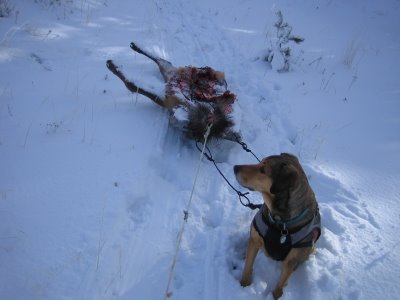 This year, I killed my elk up a little valley along the Continental Divide from where I was parked--and easy 2-mile drag through a fairly open and gently sloping downhill valley. Better yet, there was 6 or 8 inches of new snow to ease the sled's travel. Best yet, my wife had found a dog sled harness at GoodWill and so my pal RolyTheDog was able to help.
This year, I killed my elk up a little valley along the Continental Divide from where I was parked--and easy 2-mile drag through a fairly open and gently sloping downhill valley. Better yet, there was 6 or 8 inches of new snow to ease the sled's travel. Best yet, my wife had found a dog sled harness at GoodWill and so my pal RolyTheDog was able to help.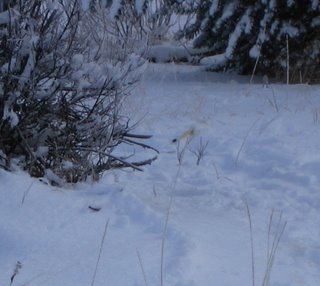 This year, I was surprised to find a weasel (ermine, when they are dressed in winter white) on my carcass. To be more exact, it was under the carcass. Initially I thought, "Oh great. The little bugger has chewed through the hide and eaten into the meat, and probably marked it to boot." (Weasels make a seriously bad odor when they mark.) But no, to my joy, the weasel seemed to have merely made a sleeping spot under the warm, well insulated hide. Tracks showed that it had been feeding on the rich fat surrounding some of the entrails. As I loaded the carcass onto my sled, the weasel watched intently, tunneling under the snow and poking its head up here and there. Too bad RTD scared it off. You can see the weasel in the pic if you look for the black tip of its tail and its two eyes.
This year, I was surprised to find a weasel (ermine, when they are dressed in winter white) on my carcass. To be more exact, it was under the carcass. Initially I thought, "Oh great. The little bugger has chewed through the hide and eaten into the meat, and probably marked it to boot." (Weasels make a seriously bad odor when they mark.) But no, to my joy, the weasel seemed to have merely made a sleeping spot under the warm, well insulated hide. Tracks showed that it had been feeding on the rich fat surrounding some of the entrails. As I loaded the carcass onto my sled, the weasel watched intently, tunneling under the snow and poking its head up here and there. Too bad RTD scared it off. You can see the weasel in the pic if you look for the black tip of its tail and its two eyes. As RTD and I approached the kill site, we also got a lesson in bird dominance order. The ravens had been on the gut pile, and they circled overhead and croaked their complaints at our approach. Immediately, though, the whiskey jacks (gray jays) moved in, feeding both on the gut pile and on the body cavity fat that I had hung in a tree for them. When I moved up to the gut pile to gather more fat to hang in the tree, the whiskey jacks moved away but a flock of chickadees came in to feed. They pecked away at the scraps even as I was hanging more in tree. Little vultures, them chicadee-dee-dee--dees.
As RTD and I approached the kill site, we also got a lesson in bird dominance order. The ravens had been on the gut pile, and they circled overhead and croaked their complaints at our approach. Immediately, though, the whiskey jacks (gray jays) moved in, feeding both on the gut pile and on the body cavity fat that I had hung in a tree for them. When I moved up to the gut pile to gather more fat to hang in the tree, the whiskey jacks moved away but a flock of chickadees came in to feed. They pecked away at the scraps even as I was hanging more in tree. Little vultures, them chicadee-dee-dee--dees.17 November 2006
Ruby Valley deer hunt
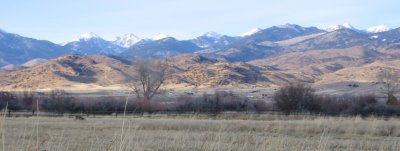
I drove over for a late afternoon hunt last week, and shot two whitetailed does after watching many deer (including seven bucks, two of which were trophy-size) for an hour. Interestingly, after I shot the first it took only 5 minutes or so for the deer to calm down. If they do not see or smell you, then the noise of shooting and act of killing does not seem to disturb them.
AJ wanted to hunt a whitetail, and though I had hoped hunting season was over I agreed to show him this marvelous place. Saturday pre-dawn found us sneaking along a fenceline into our hunting block, watching dozens of deer, and having our hearts stopped by pheasant flushing at our feet. We sat at field edge in unmown hay, but the deer within shooting range were either bucks or fawns. The does get hunted hard in the Ruby, and they can be a little scarce toward the end of hunting season.
With sunup most deer retreated from the fields, and so I sent AJ to a hunting stand just inside a brushy wood bordering the field. Because he has sometimes shot unnecessarily and because I thought he was ready for it, I gave him only a single cartridge for the rifle. Then I walked a wide circle and approached the hunting stand along another brushy border. As I neared the stand, I heard the bark of my little 25 Roberts.
AJ was bending over as I approached and he said to me, "Every animal you kill is a gift." Good student, this lad. And he now has enough meat to feed his family for the entire year.
[Below is a little poem I wrote about my daughter Emily's hunt in this same place. Pat Munday
© 2005]
Tsik, Tsik, Tsa
Kalahari hunters listen to the stars, they sing “Tsik, Tsik, Tsa.”
Late afternoon in Montana’s most beautiful river valley,
In a state full of beautiful river valleys,
Full of people thinking they live in Montana’s most beautiful river valley.
But there we were, Papa and Daughter,
Sprawled behind a fallen cottonwood,
Examining dried raccoon turds for fur, seeds, small bits of bone.
Peeking over now and then,
Surveying the field,
Willing a white-tailed deer into being.
Turkeys on the jackleg fence
Hop down to feed in wheat stubble,
Clucking soft, contented, confident chatter.
Pheasants too: Cackling; Miffed; Muscled out.
Sandhill cranes along the wood line,
Hooting and hollering on hallowed ground,
Pterodactyls on native soil.
The sun touches the western ridge,
Flocks of blackbirds fly to roost,
Pleasant distractions.
Then from thin air a young deer,
Innocent in the ways of the world,
Feeds ten feet away.
New coat fuzzy in soft light of dusk,
Harbinger preparing the way,
More muzzles peak from brush yon side of jackleg fence.
Daughter watches, memory of flesh recalls a dark clear night,
Just a baby Mother held her up arms outstretched,
“The stars are the greatest hunters, “Tsik, Tsik, Tsa.””
Mother doe and fawn leap the fence,
Six feet high touch softly down look around,
Surveying the field.
Daughter rests rifle on fallen tree,
Sights, breathes deep, squeezes,
Will she release this trigger?
At dawn stars faded fast,
She aimed and pondered, pondered and aimed,
Declined to kill a deer whose time had not come.
Rifle crack marks the time,
Child comes of age,
Star destiny fulfilled.
Papa watches the doe,
Hears the bullet smack,
Three leaps bring doe to ground.
One hundred and fifty steps later
Daughter bows to death,
Reaches out to earth’s gift.
The knife’s work is done,
Entrails pulled into a neat pile,
Liver and heart laid carefully aside.
Meat for the table,
We are blessed, “Tsik, Tsik, Tsa.”
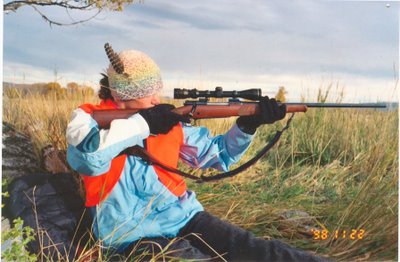
Successful Elk Hunt
 I hunted elk hard this year, but it just did not seem to be happening. So the other night I took stock of myself and decided to just be the predator and quit thinking about it so much. I thought about my little .308 Sako, the rifle Dad bought in the early 1960s, and boasted he would give to me if I shot a buck the year I turned 12. I don't believe he thought I would do it. It shot out of its first stock and is cracking the replacement (no nearly 20 years old) at the rear of the receiver. It eroded around the muzzle (don't leave the muzzle taped between hunts) and had to be shortened a bit and recrowned. But it's a wonderful, lightweight woods rifle and it shoots true.
I hunted elk hard this year, but it just did not seem to be happening. So the other night I took stock of myself and decided to just be the predator and quit thinking about it so much. I thought about my little .308 Sako, the rifle Dad bought in the early 1960s, and boasted he would give to me if I shot a buck the year I turned 12. I don't believe he thought I would do it. It shot out of its first stock and is cracking the replacement (no nearly 20 years old) at the rear of the receiver. It eroded around the muzzle (don't leave the muzzle taped between hunts) and had to be shortened a bit and recrowned. But it's a wonderful, lightweight woods rifle and it shoots true.Passing along the familiar path of Allen's flume (a 14-mile long conduit to float logs from the east to the west slope of the Continental Divide c. 1900 for the Anaconda smelter), I came upon one of the few braces left standing (see pic).
Just past sunup I cut the track of a young wolf (or, at least, a small one). A lone track, unlike a hunt along a ridge further down the valley earlier this week when I cut the tracks of big wolf and pup. I was tracking a big band of elk moving from open park to northside bedding grounds when the wolves cut in on my hunt. The tracks told the story: just as the elk were starting to bed, the pup rushed headlong into them. The wolf just ambled along at some distance, letting the pup have its head.
 The pup was of course no threat to the elk (and I doubt the lone adult wolf was, either) but it certainly made them scatter. I tracked another two miles but gave up when they headed through a valley and toward another ridge.
The pup was of course no threat to the elk (and I doubt the lone adult wolf was, either) but it certainly made them scatter. I tracked another two miles but gave up when they headed through a valley and toward another ridge. I field dressed the cow and hung some belly meat in an aspen for the hungry whiskey jacks. I like to keep on the good side of them, since occasionally they tell me where the elk are. After removing the tenderloins, I rolled the cow over, split along the spine, removed the backstraps, snicker-snacked the ribs with my vorpal hatchet, removed the spine, and finished splitting the elk. I dragged the two halves a hundred yards or so from the butchering site, covered each half with branches, pissed to marke the area and fend off coyotes (or this young wolf), and packed out the tenderloins and backstraps and heart and liver.
I field dressed the cow and hung some belly meat in an aspen for the hungry whiskey jacks. I like to keep on the good side of them, since occasionally they tell me where the elk are. After removing the tenderloins, I rolled the cow over, split along the spine, removed the backstraps, snicker-snacked the ribs with my vorpal hatchet, removed the spine, and finished splitting the elk. I dragged the two halves a hundred yards or so from the butchering site, covered each half with branches, pissed to marke the area and fend off coyotes (or this young wolf), and packed out the tenderloins and backstraps and heart and liver.13 November 2006
AJ's Mule Deer Buck
At first light, we arrived and parked at the south end of the ridge marking Dave's Deer Mine. Deer were flooding out of the alfalfa field and up the steep, rocky ridge. Even if there had been a buck among them, it was a little early to shoot. More importantly, I wanted AJ to hunt a deer and not merely shoot one.
We climbed the ridge, moving carefully and not trying to overly spook the bunches of deer that seemed to be all around us. It was a very foggy morning, and only in fits and spurts could we see more than a hundred yards or so. Though we did get a good look at a dozen or more deer, we could not put horns on any of them, and so continued along the ridge toward the saddle. At the saddle, the fog began to lift a bit.
We spotted a small herd of deer on the ridge across from us, and one was a good buck. It was much too far to shoot; after the first day's deer hunting disappointment, I was determined to keep the range well under 200 yards. Unfortunately, as the fog lifted the wind shifted and when they scented us the deer vanished into the rocks and trees at a crest in the ridge.
And so we continued working our way along the ridge's spine, swerving left and right to glass the rocks and sage and mountain mahogany on either side. Though we saw several bunches of deer, there seemed to be no bucks among them. It was the tail end of the rut, the large herds had broken up, and I feared the bucks might have left for another area.
But then we saw a few mulies feeding far below us, and as we glassed the grassy cleft between two finger ridges we saw more and more deer--mostly bedded. At 500 or 600 yards, it is difficult to see a small-antlered buck through our lightweight binoculars. When two deer began butting heads however, I knew they were bucks even before we caught a few flashes of sunlight from their antlers. This was a perfect setup for a stalk: we could back down the ridge, stay out of sight, and peek over from a prominent outcrop only a hundred yards or so from the deer.
We nearly reached that prominent outcrop when the volley of shots began from across the river. The shots were clearly being aimed toward us, though at a much lower point at the base of the ridge. We could see the four hunters, at least two of them with their rifles rested on the hood of the truck. At first I thought they might be shooting at "our" deer, but then I could see that the furthest finger ridge would block their view into the grassy cleft.
But the racket did spook our deer, and we could see the first of them beginning to move up the cleft between the finger ridges--directly at the spot where we had been sitting when we first saw them. No matter. We hurried over to the edge of the ridge, found a waist-high rock, and I unslung my knapsack as a rest for AJ to shoot from. The deer were now in a perfect single file, moving slowly but purposely along.
Toward the rear, a big forkhorn paused to look back. AJ had already spotted him. The rifel roared, the little buck flopped down, and the rest of the herd continued up and over the ridge.
Death seldom comes easily, and we watched as the deer struggled, kicked, and tried to raise his head. He was largely obscured by rock and sagebrush, and I advised AJ to shoot again only if he had a clear shot. This proved unnecessary, and within a long minute or so the buck became still and never moved again.
 We approached cautiously, partly because of the steep slope and partly because I have several times seen "dead" deer jump up and run. We admired the deer, thanked the deer and the mountain, and then the work began.
We approached cautiously, partly because of the steep slope and partly because I have several times seen "dead" deer jump up and run. We admired the deer, thanked the deer and the mountain, and then the work began.It was a fine shot, a hunter's shot. The bullet had angled in from high behind a shoulder and exited through the liver and one lung.
As always, it was a rough drag down the mountain side, through the sagebrush and over the rocks. We dropped into the coulee that drained the cleft, and though there was not much of a trail there was some snow and that helped ease the drag. As we neared the railroad tracks, I sent AJ back to the truck for the bike and I sat down to enjoy the sun, the sight of an osprey fishing the river, and my lunch.
I also watched the idiots who had shot from across the river walk up the railroad tracks cans of beeer in hand.
they found the one deer they had killed with their 7 or 8 shots, field dressed it, and begin dragging it out over the rough ballast between the tracks.

AJ arrived--much more quickly than I expected. It would have taken me a half hour or longer to reach the truck, and at least that long to return (including a pause for lunch!). We loaded the buck on the bike, setting his pelvic opening over the saddle, tying one leg to a handle bar, and the other leg and neck to the other handle bar. [I thank Rick and Sam Douglass for demonstrating this method to me many years ago, when Sam was about AJ's age.]
AJ skinned the buck that afternoon, and butchered it the next. After only one previous lesson (on his elk), he did a good job with little help. Quick study, this boy.
And now I need to find an elk for my own freezer. I hunted a certain big elk bull for the 3rd time Saturday, and for the 3rd time he outwitted me. So much for "three time's a charm." From here on, I'll be very happy to take an elk cow, thank you very much to the hunting gods.
06 November 2006
Hunting Elk in Montana

Elk season is like moonlighting at a second job.
Opening day (Sunday two weeks ago) found AJ and I high up on a ridge along the Continental Divide. The pic at left shows our view at sunrise: a valley filled with icy fog, and the peaks of the Pintler Wilderness like islands across a sea.
Several groups of hunters had put camps into this area, and it seems to have move the elk out. We did see some late in the day as we glassed through binoculars to ridges a mile or so away.
Over the course of the week, I got out once or twice more. One morning I drove a forest road up a Big Hole tributary, parked at about 7,500 feet, and hunted the whitebark pines and scree edges. The snow had warmed and refrozen and so was very noisy. But I used my time well, and spent the day following a large black bear track (see pic, below).
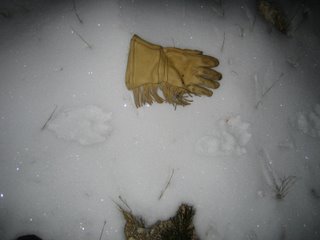
Though I never caught up with or glimpsed the bear, it was interesting seeing where it had raided squirrels' nut caches and crossed rugged areas of scree (see pic, below).

It was a glorious day to be in the mountains, and when the snow warmed up and quieted down, I said goodbye to the bear and walked down a ridge above the east side of the drainage where I had parked. I would walk a few steps, lean against a tree, pause, smell, listen, and glass the trees and deadfall. In the past I have found elk bedded on this ridge.
This day, however, they had crossed from the north side of the ridge just ahead of me. I smelled them and then saw the fresh tracks in the snow. I began following, but within an hour the day began to cool, the snow again settled into a noisy crust, and when I did get close to the elk they ran on ahead.
A day or so later I hunted another familiar place -- on a "low" ridge (7500 feet) along the Big Hole River. I hoped the snow would be quiet on the north slope and allow me to stalk closely to a bedded elk. The snow was quiet but the wind swirled and shifted. The elk -- a large, lone bull -- twice circled ahead of and above me and (as I knew from reading the tracks) watched me pass by.
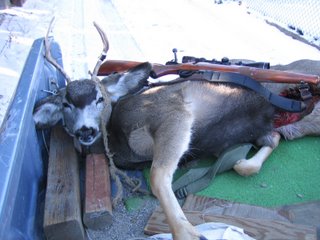 A week ago Saturday I hunted mule deer in the lower Big Hole with AJ, and mildly chastised him for missing two bucks. It was his first time shooting at big game, and he might have been a little excited. On Sunday he hunted with a family friend, so I hunted deer alone and shot a fat little forkhorn ( see pic at left). I saw a larger buck on the backside of the ridge, but shooting it would have meant (A) a big stinky mulie buck; and (B) fording across the river with the carcass to reach the nearest road. I wanted to be home by noon and those little bucks are tasty.
A week ago Saturday I hunted mule deer in the lower Big Hole with AJ, and mildly chastised him for missing two bucks. It was his first time shooting at big game, and he might have been a little excited. On Sunday he hunted with a family friend, so I hunted deer alone and shot a fat little forkhorn ( see pic at left). I saw a larger buck on the backside of the ridge, but shooting it would have meant (A) a big stinky mulie buck; and (B) fording across the river with the carcass to reach the nearest road. I wanted to be home by noon and those little bucks are tasty.This past Saturday we set off on a favorite hunt. Parking at a pass along the Divide, we hiked east a mile and then set off north down a ridge that parallels the highway for about five miles. We jumped elk at first light, and they ran across the high shallow valley to two hunters on horses where one cow was shot. The elk ran back to a ridge across from us and whistled several times. The snow was so noisy that a stalk would have been futile.
We continued down the ridge, turning our faces from a harsh 40 mph wind, and dropped into an isolated but sheltered spot where some loggers lived in drafty, tiny cabins 120 years ago when they were cutting cordwood for the Anaconda copper smelter. This is a big wide-open landscape, and only in the past 20 or so years has it begun to recover from the horrible effects of clear-cutting, acid smelter smoke poisoning, and soil erosion. Still a bit of a moonscape, there are also lush patches of bunch grass and thickly wooded bedding areas.
Just above the cabins we moved 200 yards apart through one such bedding area. A cow and calf moose nearly ran me over, and I saw one of the largest bull moose tracks I've ever seen in Montana. I also disturbed a band of elk and they ran behind AJ. He heard and saw them, but wisely did not hazard a shot at hard-to-see elk running full tilt through thick timber. We rested out of the wind, ate a snack near one of the cabins, and planned how we would hunt a high ridge to our east.
We climbed to the south end of the ridge, and AJ went along the "front" (west) side to seek out a sheltered spot to sit and watch the north end of the ridge. I went along the back side and moved through a dense stand of whitebark pines. There was abundant mule deer and elk sign. A bunch of mulie does ran past me, and when I heard AJ shoot, I worried that perhaps he had shot a mule deer buck. This is a long, long, ways to haul a deer.
But he excitedly ran down to me, explaining that about 20 elk had crossed the ridge. He was not going to shoot because they were all in full gallop, but three paused momentarily and he had taken aim on a cow. And he had shot her. A good shot, from about 200 yards away. From the foamy pinkish blood I knew it was a lung hit. As we carefully and slowly followed her down the steep slope, she left a good blood trail. Periodically, there were great gushes of blood, and I theorized that it was a high lung shot, and that the chest would fill with blood and then she would blow it out. As AJ followed the blood trail through thick cover, I circled out to the edges just in case she broke out. But she did not, and when AJ got to the bottom I heard him shoot again. He had found the cow down and unable to stand, and had taken a finishing shot. I congratulated him on this first kill, and we paused to admire and thank the elk.
I removed the ivory tusks, handed them to him, and explained their significance as a memory and treasure from the hunt.
"Now the work begins," I found myself saying--just as my grandfather said countless times to me after shooting a whitetailed deer on some Allegheny ridge. AJ made neat work of the field dressing, with a little instruction and a guiding hand. He removed the tenderloins, set them aside with the liver and heart, and we rolled the carcass over. He split it along the spine and removed the backstrap from each side. I then used my little hatchet to snicker-snack the ribs away from the spine and to finish splitting the carcass at pelvis and brisket.
We dragged each half to a shaded, snowy spot, and covered the meat with branches from a Douglas fir. then loaded our knapsacks with backstrap and tenderloin and liver and heart, and began the trek out.
Sunday we returned with my game sled and I threw the backpacks in the truck, "just in case." We dragged the first half out with the sled, which was hell: dry ground, grass, willow & alder thickets, and aspen stobs & deadfall along the beaver dams. It took three hours. So for the second half we brought the backpacks and AJ built a nice warming fire while I boned out the meat. This was much easier, given the dry and rugged trail out. We made it out of the canyon at dark, hung the elk half and put the bags of boned out meat in my mudroom. (see pic, below) Yesterday I picked up AJ after school and we cut & wrapped the first half. Today we'll cut & wrap the second half. Tomorrow or the next day we'll grind the scraps into sausage.
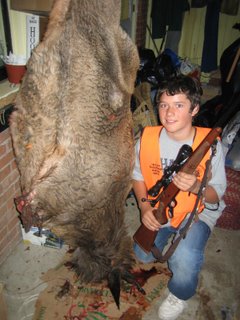 AJ is a happy hunter, and a little bit lucky to have killed an elk in his 2nd day of hunting. His family will have about 150 pounds of meat in the freezer. Prime, tasty, and "all natural." And as the oldtimers say (God, I think I'm turning into an oldtimer), the harder it is to get an elk out of the woods, the better it tastes.
AJ is a happy hunter, and a little bit lucky to have killed an elk in his 2nd day of hunting. His family will have about 150 pounds of meat in the freezer. Prime, tasty, and "all natural." And as the oldtimers say (God, I think I'm turning into an oldtimer), the harder it is to get an elk out of the woods, the better it tastes.Later this week, I think my body has recovered enough to go elk hunting for myself. And we still need to find AJ a mulie buck to top off his family's freezer.



